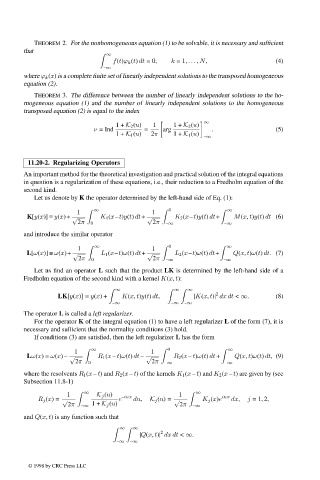Page 611 - Handbook Of Integral Equations
P. 611
THEOREM 2. For the nonhomogeneous equation (1) to be solvable, it is necessary and sufficient
that
∞
f(t)ϕ k (t) dt =0, k =1, ... , N, (4)
–∞
where ϕ k (x) is a complete finite set of linearly independent solutions to the transposed homogeneous
equation (2).
THEOREM 3. The difference between the number of linearly independent solutions to the ho-
mogeneous equation (1) and the number of linearly independent solutions to the homogeneous
transposed equation (2) is equal to the index
∞
1+ K 2 (u) 1 1+ K 2 (u)
ν = Ind = arg . (5)
1+ K 1 (u) 2π 1+ K 1 (u)
–∞
11.20-2. Regularizing Operators
An important method for the theoretical investigation and practical solution of the integral equations
in question is a regularization of these equations, i.e., their reduction to a Fredholm equation of the
second kind.
Let us denote by K the operator determined by the left-hand side of Eq. (1):
∞ 0 ∞
1 1
K[y(x)] ≡ y(x)+ √ K 1 (x–t)y(t) dt+ √ K 2 (x–t)y(t) dt+ M(x, t)y(t) dt (6)
2π 0 2π –∞ –∞
and introduce the similar operator
0
1 ∞ 1 ∞
L[ω(x)] ≡ ω(x)+ √ L 1 (x–t)ω(t) dt+ √ L 2 (x–t)ω(t) dt+ Q(x, t)ω(t) dt. (7)
2π 0 2π –∞ –∞
Let us find an operator L such that the product LK is determined by the left-hand side of a
Fredholm equation of the second kind with a kernel K(x, t):
∞ ∞ ∞
2
LK[y(x)] ≡ y(x)+ K(x, t)y(t) dt, |K(x, t)| dx dt < ∞. (8)
–∞ –∞ –∞
The operator L is called a left regularizer.
For the operator K of the integral equation (1) to have a left regularizer L of the form (7), it is
necessary and sufficient that the normality conditions (3) hold.
If conditions (3) are satisfied, then the left regularizer L has the form
∞ 0 ∞
1 1
Lω(x) ≡ ω(x) – √ R 1 (x – t)ω(t) dt – √ R 2 (x – t)ω(t) dt + Q(x, t)ω(t) dt, (9)
2π 0 2π –∞ –∞
where the resolvents R 1 (x – t) and R 2 (x – t) of the kernels K 1 (x – t) and K 2 (x – t) are given by (see
Subsection 11.8-1)
∞ ∞
1 K j (u) –iux 1 iux
R j (x)= √ e du, K j (u)= √ K j (x)e dx, j =1, 2,
2π –∞ 1+ K j (u) 2π –∞
and Q(x, t) is any function such that
∞ ∞
2
|Q(x, t)| dx dt < ∞.
–∞ –∞
© 1998 by CRC Press LLC
© 1998 by CRC Press LLC
Page 594

